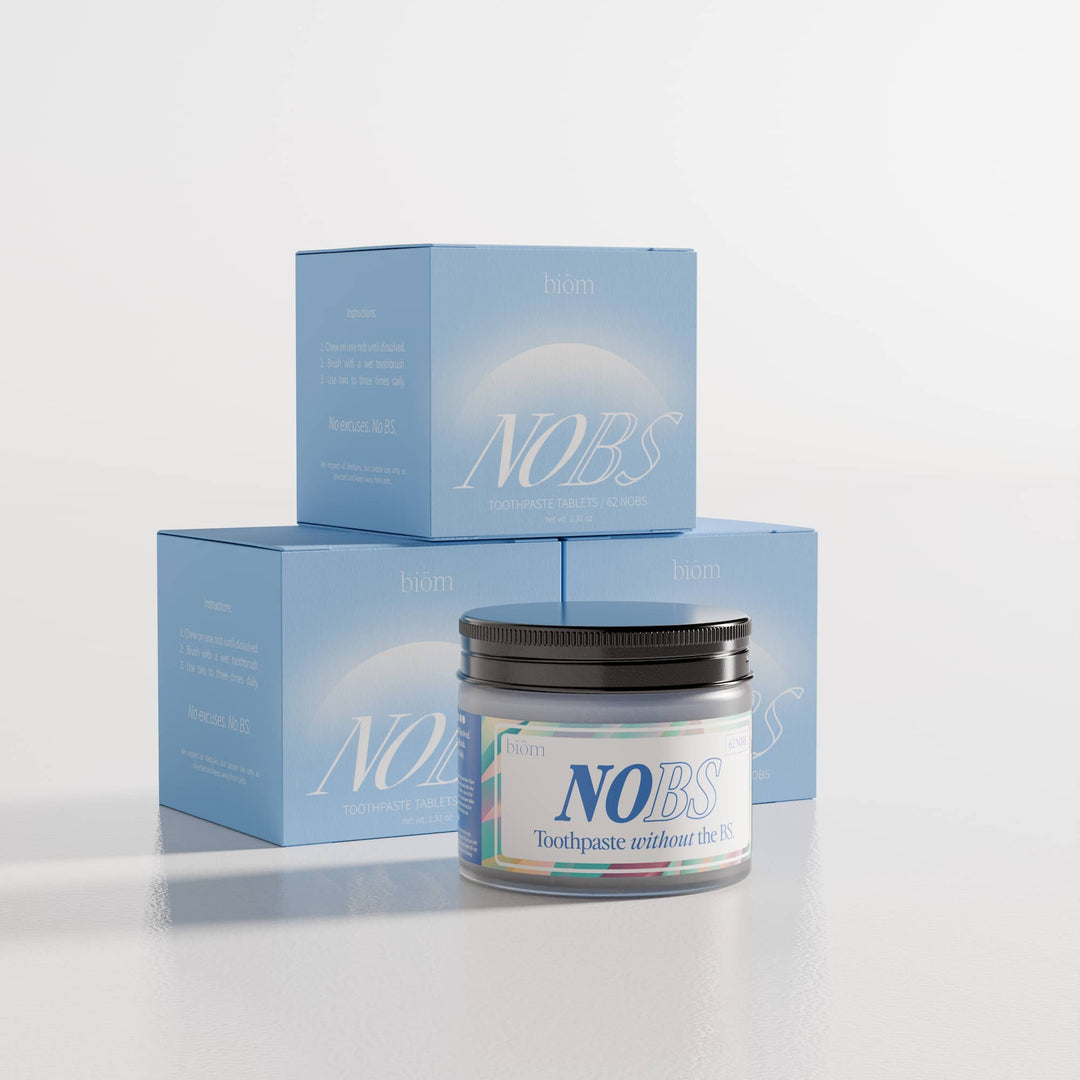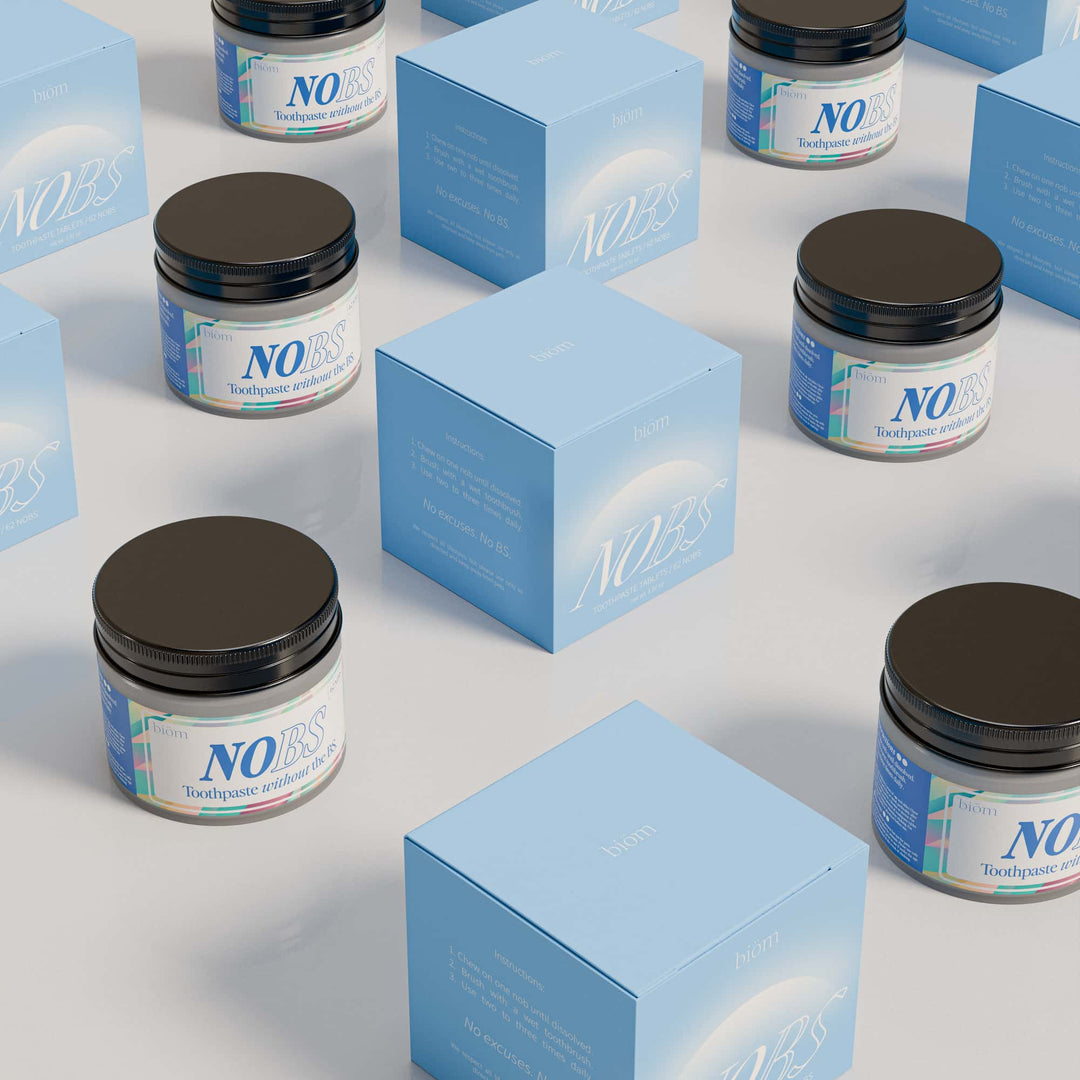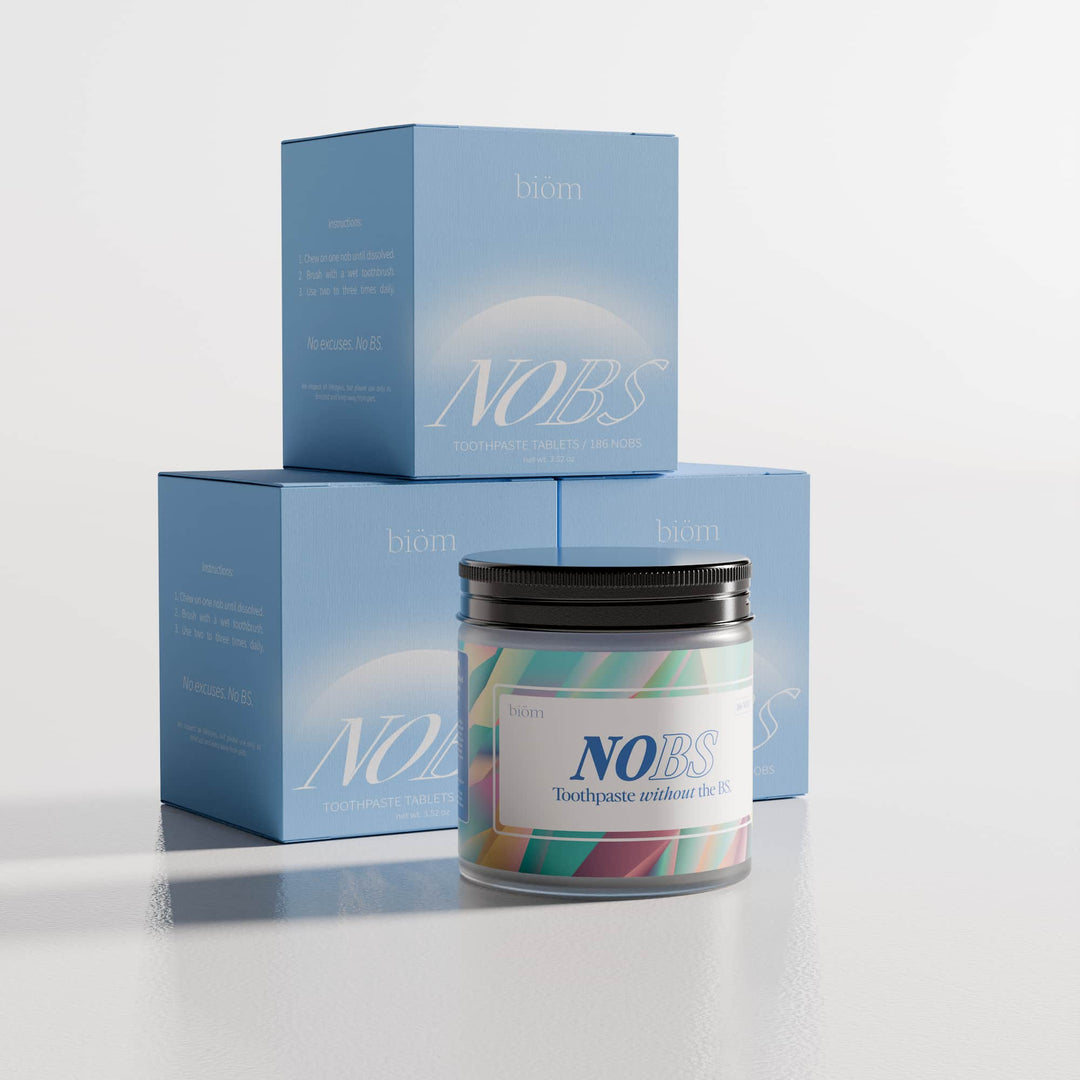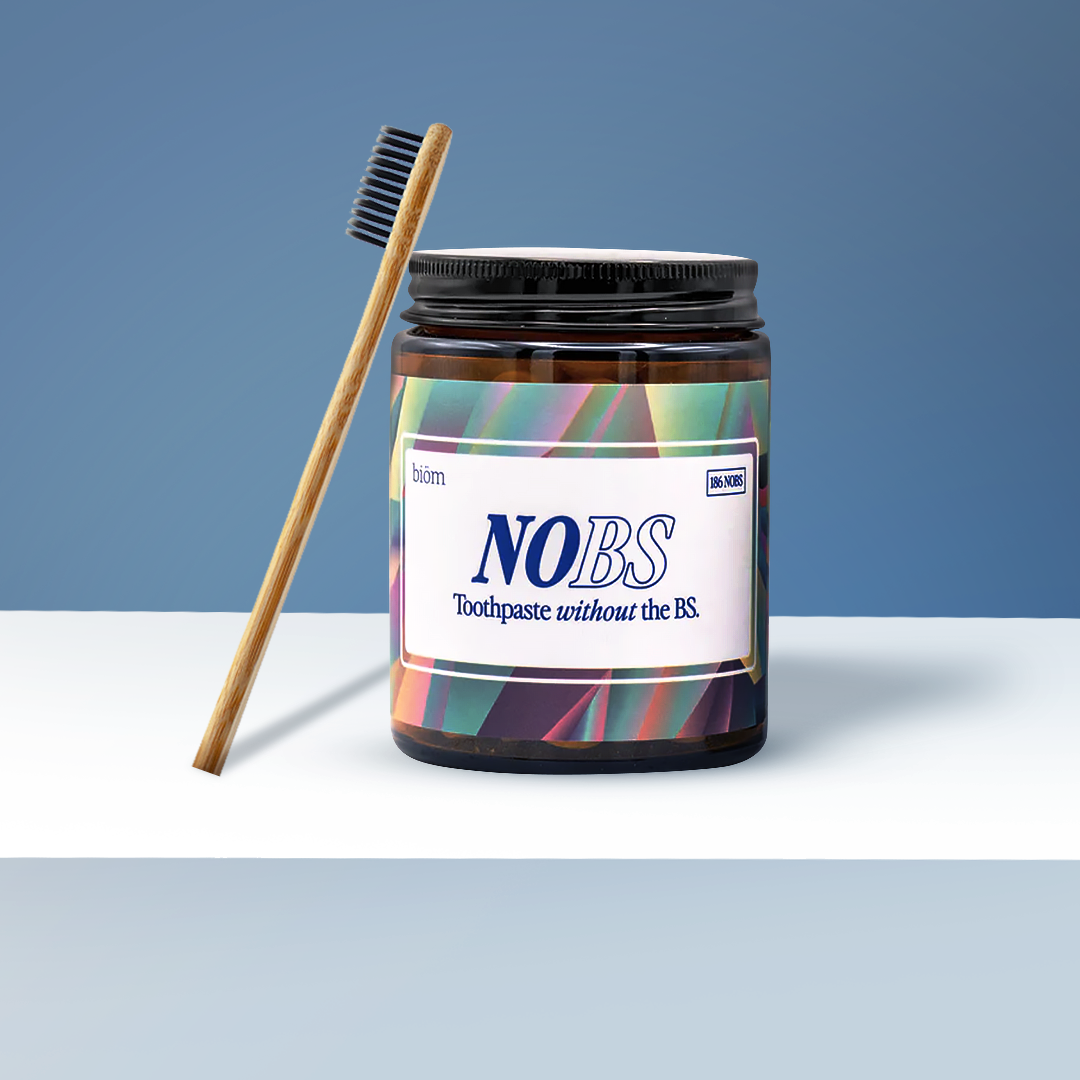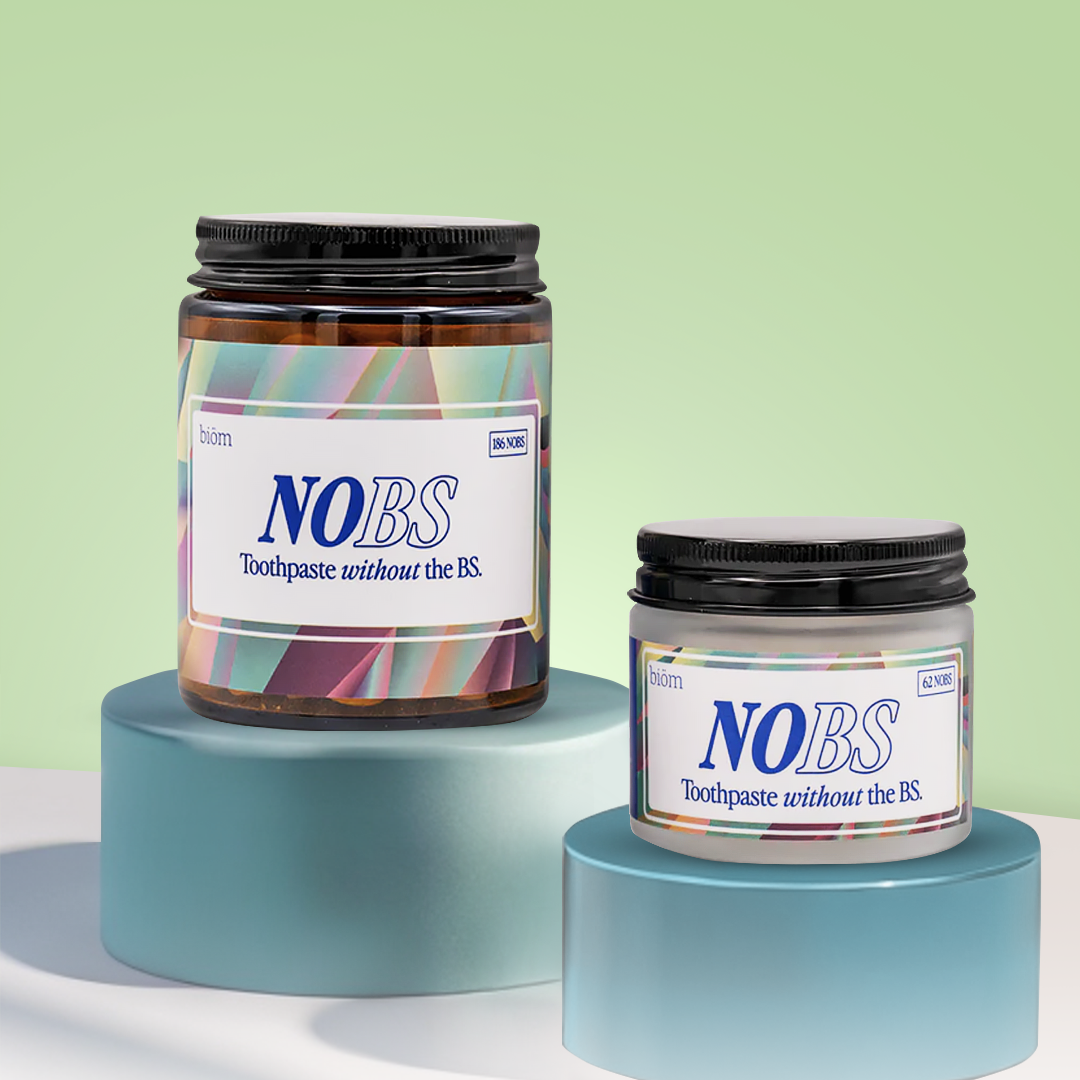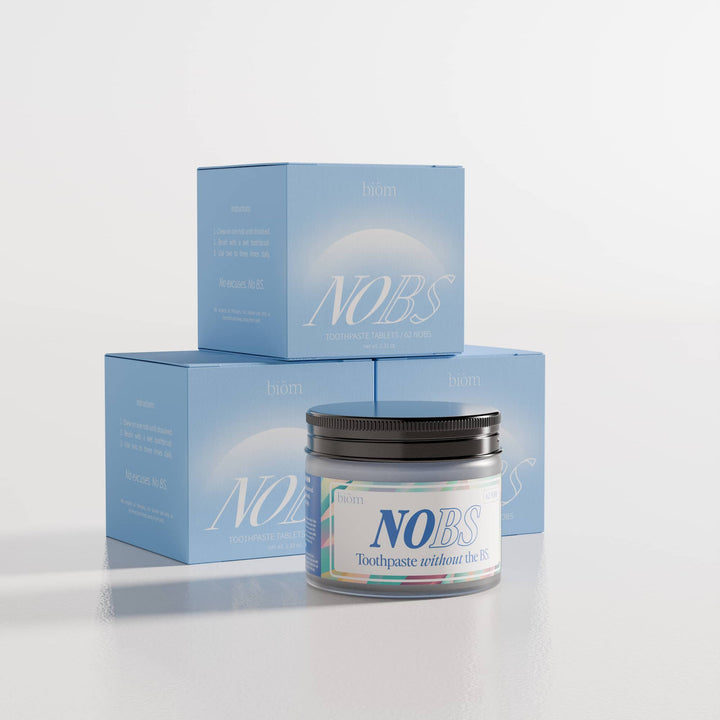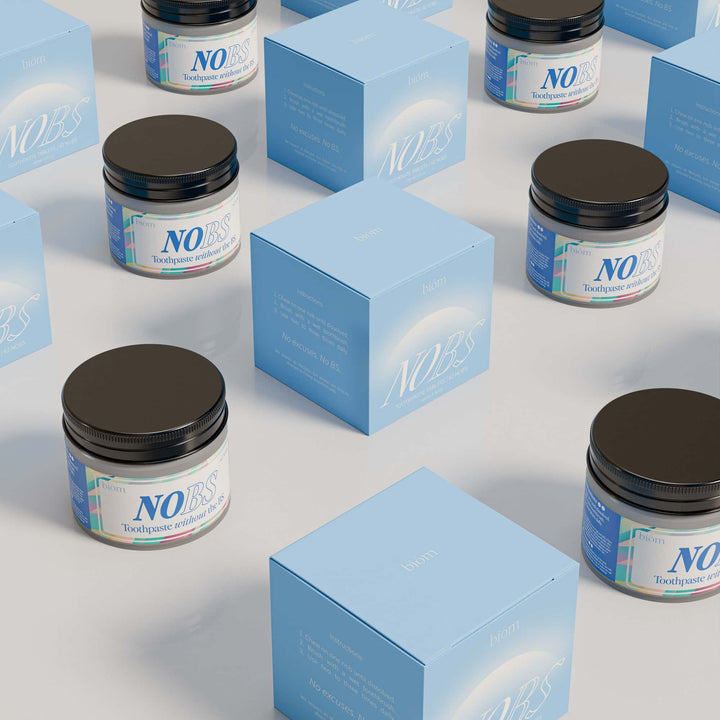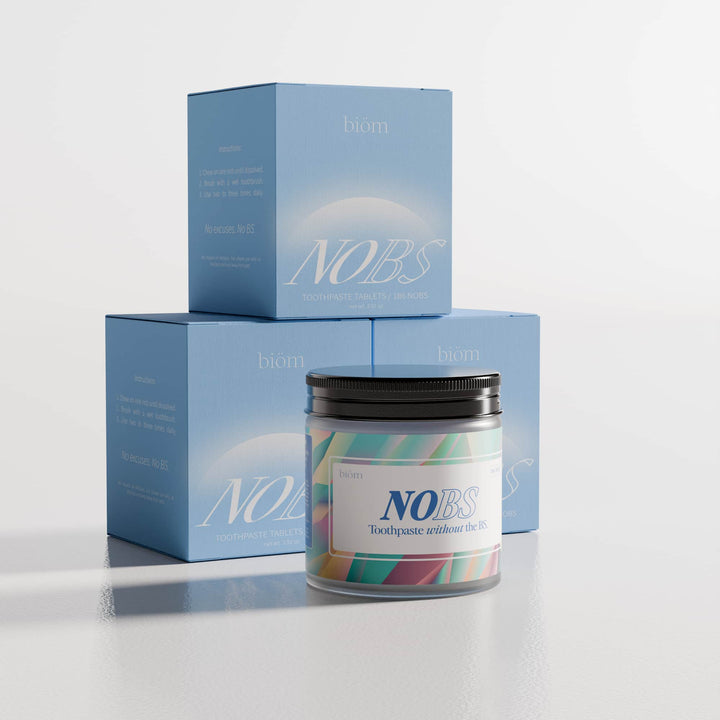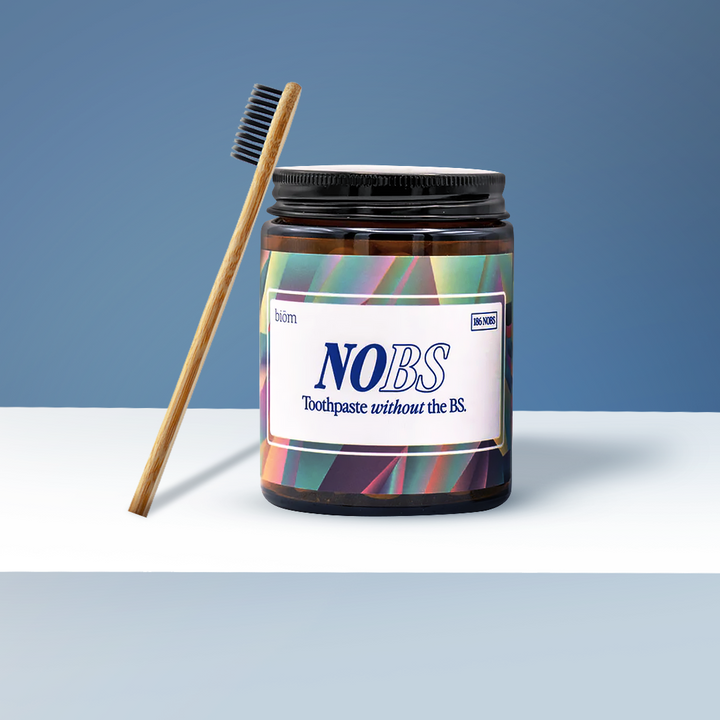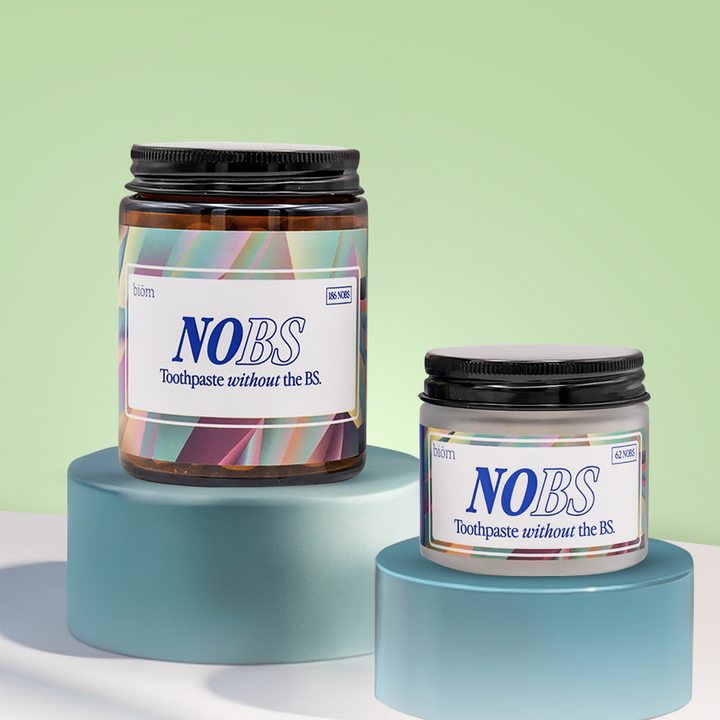What is Hydroxyapatite, and Why is it in Your Toothpaste?
Hydroxyapatite is a naturally occurring mineral composed of calcium and phosphate that is often included in toothpaste formulations thanks to its ability to remineralize and strengthen enamel.
Because hydroxyapatite closely mimics the natural composition of our teeth and bones, it's an excellent tool for strengthening our teeth and preventing tooth decay. You see, as our teeth get exposed to acids throughout our daily lives, our enamel is worn away in a process known as demineralization.
Thankfully, we have tools like hydroxyapatite toothpaste that can reintroduce essential minerals back into our teeth and strengthen them. This process is known as remineralization, and it rebuilds weakened enamel that may otherwise progress into tooth decay.
Of course, thanks to its biomimetic nature, hydroxyapatite has a wide range of other uses across medicine and dentistry as well.
In this article, I'll explain everything you need to know about hydroxyapatite and why it's a crucial component of regenerative medicine.
Hydroxyapatite Overview

Hydroxyapatite (also referred to as simply "HA") is a naturally occurring mineral that is the primary inorganic component of human teeth and bones.
It is a crystalline structure composed of calcium and phosphate ions, making it a vital component of the hard tissues in our bodies. In fact, hydroxyapatite gives our teeth and bones their strength and hardness.
In the context of teeth, hydroxyapatite is a key component of tooth enamel, which is the outermost layer of the tooth surface. Enamel is the hardest substance in the human body, and it protects the underlying dentin and pulp of the tooth.
Hydroxyapatite is also used in various dental and medical applications, including dental implants, bone grafts, and as a biomaterial in orthopedic surgery.
Where does hydroxyapatite come from?
Hydroxyapatite is found naturally within the human body as a major part of our skeletal and dental systems. Not only does it contribute human bone hardness and density, but hydroxyapatite crystals also help facilitate mobility and protect our organs.
Further, hydroxyapatite is a major component of our tooth enamel, protecting it from acidic damage. It's the stuff that prevents you from feeling discomfort when chewing, while eating especially hot or cold foods, and when consuming acidic foods and beverages.
Also, hydroxyapatite is naturally found within the Earth's crust, and our modern technology allows for controlled laboratory synthesis of hydroxyapatite. Thanks to this technology, hydroxyapatite has uses across medical industries, including orthopedic and dental implants, remineralizing toothpaste, and even bone tissue engineering.
Hydroxyapatite Uses

Hydroxyapatite is has many applications in dentistry and regenerative medicine, including:
-
use in toothpaste to remineralize enamel and reverse tooth decay
-
use in orthopedic implants and bone grants to support biocompatibility and speed up wound healing
-
use in cosmetics to improve texture and create unique matte finishes
These diverse applications showcase the versatility of hydroxyapatite in improving health, aesthetics, and materials in various fields. That said, of all of these, hydroxyapatite is most well known for its application in remineralizing toothpaste.
Dental Implants
Hydroxyapatite is used in dental implants to improve their integration with the surrounding bone tissue in a process known as osseointegration.
Dental implants are sort of like artificial teeth that get surgically placed in the jawbone. Typically, they're used to support other dental treatments like crowns.
When researchers apply hydroxyapatite coatings to the implant surface, the implant is better able to mimic the natural composition of our bones. This improves the implant's biocompatibility and reduces the risk of adverse reactions, like inflammation.
Further, research suggests that hydroxyapatite coatings on dental implants promote faster healing, reduce recovery time, and increase the longevity of dental implants.
Bone Grafts

Bone grafts are used in bone tissue engineering to replace missing bone tissue or for bone regeneration due to injuries, diseases, or surgeries.
Hydroxyapatite, in the form of granules, powders, or porous scaffolds, is often used as a bone graft material. This is because hydroxyapatite's natural composition is similar to bone mineral, making it an ideal choice for promoting bone tissue regeneration in the following ways:
-
providing a scaffolding for new bone formation
-
allow bone cells to attach and proliferate
-
and its ability to facilitate and stimulate bone growth
Further, because hydroxyapatite is a biomimetic substance, it's well-tolerated and unlikely to cause any adverse reactions during bone repair.
Cosmetic Dentistry
In cosmetic dentistry, hydroxyapatite plays a significant role in improving the aesthetics, health, and appearance of teeth.
Cosmetic dentists may use hydroxyapatite-based materials for various procedures aimed at enhancing smiles and addressing common aesthetic concerns:
-
Tooth Bonding: Hydroxyapatite can be used as a dental bonding material to repair chipped or cracked teeth. Cosmetic dentists apply a tooth-colored resin containing hydroxyapatite to the affected tooth, sculpting it to match the natural tooth shape.
-
Tooth Whitening: Hydroxyapatite is sometimes incorporated into tooth whitening treatments. It can help remove surface stains and discolorations, contributing to a brighter and more radiant smile.
-
Veneers: Hydroxyapatite-based materials are used to create dental veneers, thin shells that are custom-made to fit over the front surface of teeth. Veneers can mask imperfections such as stains, gaps, and misaligned teeth, providing patients with a more attractive smile.
-
Composite Fillings: Some modern composite dental fillings contain hydroxyapatite. These fillings are not only functional but also blend seamlessly with the natural tooth color, ensuring a more aesthetically pleasing result.
Plus, nano hydroxyapatite toothpaste tablets are an effective tool to prevent tooth decay, soothe hypersensitivity, and whiten teeth.
Toothpaste and Oral Care Products

Of course, we have to talk about hydroxyapatite in toothpaste and other oral care products! Because hydroxyapatite closely mimics the natural composition of our teeth, it's an ideal agent for promoting remineralization.
Thus, hydroxyapatite toothpaste can deposit calcium phosphates back into our teeth which helps restore enamel that is under constant attack of demineralization from the acids produced by our naturally occurring oral bacteria or our diets.
Through the remineralization process, hydroxyapatite toothpaste:
-
protects against tooth decay
-
reduces sensitivity
-
and whitens teeth.
While you cannot remineralize a cavity once it has formed, we do know that hydroxyapatite is a key player in remineralization which can help prevent the initial stages of demineralization and tooth decay.
Beyond toothpaste, hydroxyapatite is also used in mouthwash, dental gels, and even chewing gum. In these products, it serves similar benefits as it does it toothpaste.
So, is it safe to use?
Yes, both hydroxyapatite and nano hydroxyapatite are safe to use. In fact, research indicates that nano hydroxyapatite toothpaste may have fewer safety concerns compared to fluoride toothpaste.
Nano hydroxyapatite particles and hydroxyapatite particles do not induce toxicity the way overconsumption of fluoride can. This is particularly important for certain populations such as:
-
pregnant women
-
children
-
people prone to tooth decay and cavities
-
people who live in environments with high fluoride concentrations in the water
Therefore, choosing nano hydroxyapatite toothpaste tablets can be your ideal step toward a safer and more effective oral care routine.
Is hydroxyapatite safe for kids?

Yes, both hydroxyapatite and nano hydroxyapatite are safe for kids. In fact, nano hydroxyapatite is considered by many dentists as a better alternative to fluoride for children for a number of developmental and physical reasons.
For example, some researchers suggest hydroxyapatite is a promising solution early childhood caries. Further, a meta analysis concluded that, "biomimetic hydroxyapatite-containing, fluoride-free oral care products are effective in reducing dental decay, especially in children."
Finally, another study using the International Caries Detection and Assessment System concluded, at the end of a year-long trial, that hydroxyapatite toothpaste was not inferior to a fluoride control toothpaste.
Why is hydroxyapatite in my toothpaste?
Hydroxyapatite is primarily included in toothpaste for its remineralization ability. In toothpaste, hydroxyapatite particles restore and strengthen our tooth enamel by depositing calcium phosphate ions.
You see, when our enamel is exposed to acids produced by the bacteria that naturally live in our mouths or dietary acids/sugars, it can become demineralized. This leads to weakened enamel, tooth sensitivity, and tooth decay. If left untreated, that tooth decay can progress into full blown dental caries.
Since hydroxyapatite is a biometric compound and closely mimics the natural mineral composition of our teeth, it is easily able to remineralize enamel and protect us from all kinds of dental issues.
Studies also show that hydroxyapatite toothpaste can prevent plaque buildup which can otherwise lead to tartar development and cavities. Further, more research suggests that hydroxyapatite can also whiten teeth as the remineralization process may remove surface stains.
Benefits of Hydroxyapatite Toothpaste

Hydroxyapatite and its more effective cousin nano hydroxyapatite are making waves for all of the incredible benefits they offer for your teeth. Benefits of brushing with hydroxyapatite containing toothpastes include:
-
enamel remineralization
-
strengthening teeth
-
preventing tooth decay
-
reducing hypersensitivity
-
whitening teeth
-
and supporting your oral microbiome.
Plus, nano hydroxyapatite toothpaste is safe for adults and children alike. In fact, kids hydroxyapatite toothpaste even protects them from side effects of over-consuming fluoride, like dental fluorosis.
Hydroxyapatite Toothpaste vs. Hydroxyapatite Toothpaste Tablets
Hydroxyapatite toothpaste and hydroxyapatite toothpaste tablets are both oral care products that use hydroxyapatite to remineralize teeth and promote overall oral health.
At a high level, hydroxyapatite toothpaste has a traditional toothpaste texture and format. This is probably the most similar type of toothpaste that you're familiar with. With hydroxyapatite toothpaste, you dispense about a pea-sized amount onto your toothpaste and brush just like you would with regular toothpaste.
On the other hand, hydroxyapatite toothpaste tablets are a dehydrated form of hydroxyapatite toothpaste, compressed into a small tablet form. This chewable toothpaste is compact, eco-friendly, and reduces plastic waste.

To use toothpaste tablets, you simply chew it until it dissolves into a traditional, foamy toothpaste. Then, you brush your teeth with that paste as usual for two minutes morning and night.
While hydroxyapatite toothpaste and hydroxyapatite toothpaste tablets are similar, toothpaste tablets offer benefits like:
-
convenience for travel
-
increased sustainability
-
fewer ingredients and preservatives
-
and reduced risk of allergy due to fewer ingredients.
Plus, toothpaste tablets are also mess-free and waterless, so you can easily throw them in your carry-on bag unlike regular toothpaste, and they won't make a mess.
Hydroxyapatite vs. Nano Hydroxyapatite
Nano hydroxyapatite and hydroxyapatite are both forms of the same compound, but they differ slightly in efficacy and benefits.
In fact, one paper from 2023 even stated, "Compared to HA, nHA is found to have superior properties such as increased solubility, high surface energy and better biocompatibility. This is due to the morphological and structural similarity of nanosized hydroxyapatite particles to tooth hydroxyapatite crystals."
Because nano hydroxyapatite particles are much smaller than hydroxyapatite, nano hydroxyapatite toothpaste is more effective at:
-
preventing tooth decay
-
strengthening teeth
-
soothing hypersensitivity
-
and whitening teeth and reducing discoloration.
Essentially, because hydroxyapatite nanoparticles are so small, they're better able to integrate into the tooth structure and remineralize enamel. Therefore, in comparing hydroxyapatite vs nano hydroxyapatite, nano hydroxyapatite toothpastes provide increased oral hygiene benefits over hydroxyapatite toothpastes.
Hydroxyapatite vs. Fluoride

We often see hydroxyapatite and fluoride being used in toothpaste formulations, but how do these ingredients truly perform, and how do they differ from one another?
Let's walk through some of the key differences in comparing hydroxyapatite vs fluoride.
How They Work
Hydroxyapatite and fluoride take different approaches when it comes to protecting our teeth.
Hydroxyapatite toothpaste works by forming a new layer of hydroxyapatite on the surface of the tooth, which integrates into the natural tooth structure, strengthening and remineralizing it.
Meanwhile, fluoride toothpaste works by reacting with the saliva in your mouth to create fluorapatite, a substance that helps prevent tooth decay by promoting remineralization of tooth enamel.
Efficacy
Numerous studies suggest that fluoride has long been effective in reducing caries due to its capability of integrating into the tooth enamel and fighting off harmful bacteria.
However, a recent study indicates that hydroxyapatite toothpaste is equally, if not more, effective in remineralizing initial caries lesions and reducing the formation of plaque.
Another study from 2023 concluded, "[hydroxyapatite toothpaste] is not statistically inferior to fluoride toothpaste."
Safety
While both fluoride and hydroxyapatite toothpaste are generally safe for daily use, there are certain considerations for each.
For instance, overconsumption of fluoride, especially in young children, could lead to dental fluorosis, fluoride toxicity, and more. On the contrary, nano hydroxyapatite is biomimetic and safe as it is already a substance naturally present in our teeth, which makes it less likely to cause any harm when use.
One paper even states: "Thus far in the literature, there have been no reports of adverse dental or systemic effects of HAP-containing toothpastes because HAP has an excellent biocompatibility"
Is hydroxyapatite better than fluoride?
Yes, hydroxyapatite can be considered better than fluoride as it offers similar benefits without the associated toxicity.
It provides the advantages of fluoride, such as cavity protection, sensitivity reduction, and enamel remineralization, but without the potential harm linked to fluoride ingestion.
Hydroxyapatite is non-toxic and safe enough to swallow, unlike fluoride, which can cause dental and skeletal fluorosis if overexposed.
That's why choosing hydroxyapatite can be a safer and better alternative for oral care.
However, it is always recommended to consult with a dental professional for personalized recommendations.
Can I use hydroxyapatite and fluoride together?

Yes, you can use hydroxyapatite and fluoride together, and there may be certain advantages to doing so.
Hydroxyapatite toothpaste is known for its ability to promote enamel remineralization and strengthen teeth as is fluoride toothpaste. Combining these two different types of toothpaste may offer unique and thorough dental protection as hydroxyapatite excels in enamel repair and fluoride is FDA approved for treating cavities.
To maximize the benefits of both types of toothpaste, we recommend using them separately throughout the day. For example, you can brush with nano hydroxyapatite toothpaste tablets in the morning. Then, in the evening, you can brush with fluoride toothpaste after using a tongue scraper and expandable floss.
This dual approach can maximize the benefits of both ingredients and provide a healthy solution for preventing cavities.
Where to get hydroxyapatite toothpaste?
Hydroxyapatite toothpaste, a natural mineral that helps strengthen enamel and reduce sensitivity, is available over the counter or online.
You can find it in several brands offering fluoride-free alternatives. One popular option is NOBS Toothpaste Tablets by Biom, which includes hydroxyapatite for effective oral care.
These toothpaste tablets are easy to find online through various retailers. If you're looking for a fluoride-free solution that mimics the natural composition of your teeth, hydroxyapatite toothpaste is a great choice to consider for daily oral hygiene.
Summary: Hydroxyapatite Toothpaste
Hydroxyapatite is a naturally occurring mineral that is used in toothpaste for its ability to strengthen and remineralize enamel. Essentially, hydroxyapatite mimics the natural mineral composition of our teeth thanks to calcium and phosphate ions.
When our teeth are exposed to acids that wear away at enamel, hydroxyapatite toothpaste is a useful tool to deposit essential minerals back into our teeth. This process, known as remineralization, repairs weakened, demineralized enamel that could otherwise turn into tooth decay.
Also, hydroxyapatite toothpaste is uniquely beneficial for its ability to alleviate tooth sensitivity. It works by sealing off these tiny channels in our teeth, known as dentinal tubules, that transmit "feelings" and "sensations" to the underlying nerve.
By blocking off the tubules, hydroxyapatite effectively fights sensitivity and discomfort typically associated with consuming hot or cold foods and beverages.
In conclusion, thanks to its biocompatible nature with our teeth and bones, hydroxyapatite is an excellent ingredient in toothpaste to prevent tooth decay and hypersensitivity.
Frequently Asked Questions
What does hydroxyapatite do for the body?
Hydroxyapatite forms the mineral basis of our bones and teeth and provides them with the strength and density needed for support. In our bones, hydroxyapatite crystals align to create a robust structural framework. Then, in teeth, hydroxyapatite makes up the majority of tooth enamel, protecting it from decay. Beyond structural support, hydroxyapatite can also be used in various medical applications, such as orthopedic implants, bone grafts, and dental fillers, due to its biocompatible and osteoconductive properties.
Is hydroxyapatite good for teeth?
Yes, hydroxyapatite is good for teeth thanks to its ability to promote enamel remineralization, strengthen teeth, and reduce hypersensitivity. As a natural component of teeth, hydroxyapatite mimics the mineral composition of enamel, allowing it to effectively repair weakened or demineralized areas of the tooth surface. By depositing essential minerals like calcium and phosphate, hydroxyapatite toothpaste can enhance enamel resilience and help prevent tooth decay. Additionally, hydroxyapatite can effectively seal off dentinal tubules which reduces tooth sensitivity.
What are the concerns with hydroxyapatite?
There are no concerns with hydroxyapatite. In fact, there are no known disadvantages or side effects of nano hydroxyapatite in toothpaste. Research states that there is no literature reporting any systemic or adverse effects of hydroxyapatite containing toothpastes. That's why many people are turning to nano hydroxyapatite toothpaste as a safe, non-toxic alternative to fluoride toothpaste.
Is hydroxyapatite the same as calcium?
No, hydroxyapatite is not the same as calcium, although it does contain calcium as one of its components. Hydroxyapatite is a naturally occurring mineral and a calcium phosphate compound that forms the primary mineral structure of bones and teeth. It consists of calcium, phosphate, hydroxide ions, and other elements. While calcium is a crucial element for overall health and is found in various forms in the body, hydroxyapatite is a specific mineral compound with a unique chemical structure, making it distinct from elemental calcium.
What foods have hydroxyapatite?
Hydroxyapatite is not typically found in foods as a standalone compound. Instead, it is a naturally occurring mineral that primarily constitutes the mineralized structure of bones and teeth within the human body. However, foods rich in calcium and phosphate can indirectly support the body's formation and maintenance of hydroxyapatite. Dairy products like milk, cheese, and yogurt are excellent sources of calcium. Additionally, leafy green vegetables, nuts, and certain fish such as salmon and sardines provide dietary calcium and phosphorus and contribute to overall bone health. Thus, by extension, these foods can support the formation of hydroxyapatite within the human body.
How does hydroxyapatite toothpaste work?
Hydroxyapatite toothpaste works by mimicking the natural mineral structure of tooth enamel, helping to repair and strengthen it. It fills in microscopic cracks and smooths the surface, reducing sensitivity and protecting against cavities. This non-fluoride option promotes overall tooth health while enhancing enamel strength.
Does hydroxyapatite toothpaste have disadvantages?
Generally, hydroxyapatite toothpaste is considered safe for most individuals, with minimal risk of side effects. This is supported by various studies that consistently report zero adverse health effects associated with hydroxyapatite toothpaste.
Can you use hydroxyapatite toothpaste with braces?
Yes, hydroxyapatite toothpaste can be used with braces. It helps remineralize enamel, which can be beneficial in preventing white spots and decay around brackets. Additionally, it is gentle and safe for orthodontic treatment, promoting overall oral health during the braces process.
What is the source of hydroxyapatite?
Hydroxyapatite is a naturally occurring mineral form of calcium apatite, found in bones and teeth. It can also be synthetically produced for use in dental products. Its structure is similar to the enamel in our teeth, making it ideal for remineralization.
Where do you find hydroxyapatite?
Hydroxyapatite is found in human bones and teeth, as well as in some fish bones and coral. It is also commonly used in medical and dental applications for bone grafts and tooth care products.
What are the negatives of hydroxyapatite toothpaste?
There are no known negatives or side effects of nano hydroxyapatite in toothpaste. Research states that there is no literature reporting any systemic or adverse effects of hydroxyapatite containing toothpastes. In fact, that's why many people are turning to nano hydroxyapatite toothpaste as a safe, non-toxic alternative to fluoride toothpaste.
Can hydroxyapatite heal teeth?
Yes, hydroxyapatite can help remineralize and repair enamel in early stages of demineralization by replenishing lost minerals. It does not reverse cavities but can strengthen and protect teeth against further damage.
What is the function of the hydroxyapatite crystals?
Hydroxyapatite crystals play a vital role in strengthening and protecting teeth. They are the primary mineral component of enamel and dentin, helping to repair microscopic damage and fill in surface imperfections. This function improves enamel resilience, reduces sensitivity, and enhances overall tooth health.
Is hydroxyapatite safe for teeth?
Yes, hydroxyapatite, including its nano form, is safe and effective for use in toothpaste. Research shows that nano hydroxyapatite has fewer safety concerns than fluoride and is particularly beneficial for vulnerable groups like children, pregnant women, and those in high-fluoride areas. Since it mimics the natural substance in teeth, it is biocompatible and unlikely to cause harm when used regularly.
Why is nano hydroxyapatite banned?
Rod-shaped nano hydroxyapatite is not banned in the United States or the European Union. In fact, it is approved for use up to 10% concentration in toothpaste. However, needle-shaped nano hydroxyapatite is banned in the European Union for suspicion of causing cell damage if ingested in large quantities.


